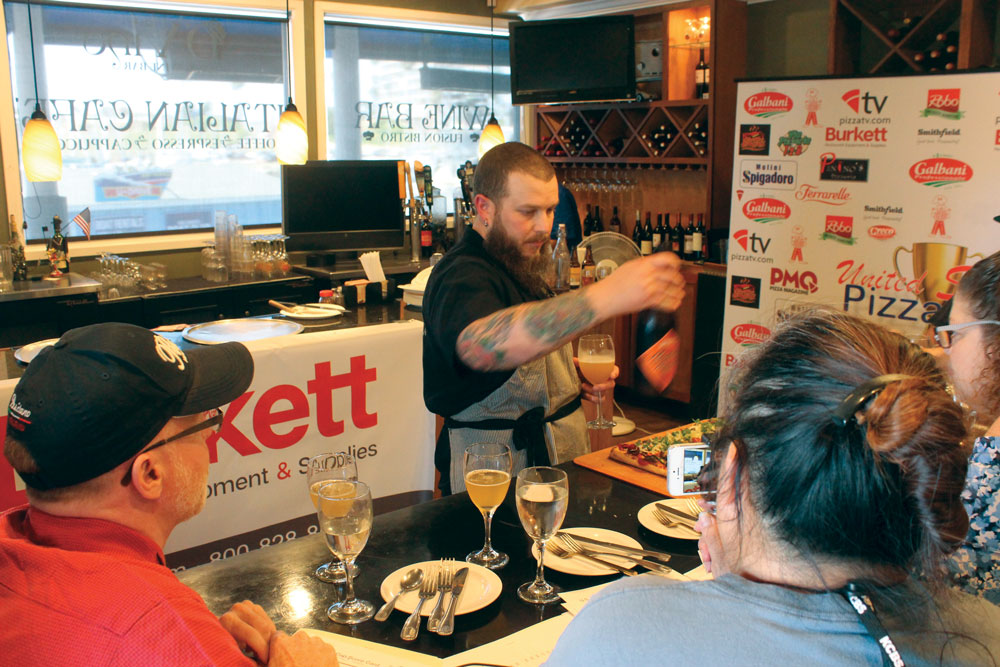In an endless sea of chains and cookie-cutter pizzerias, you have to find a way to set yourself apart. One great way to do that, while giving back to your community, is to source ingredients locally whenever possible. U.S. Pizza Team member Lars Smith, owner of State of Mind Public House and Pizzeria in Los Altos, California, knew this was the way to go right from the beginning. Known for his predominantly “California local” menu of ingredients—from meats to produce to cheeses—Smith explains how and why operators should consider sourcing and serving “local” to locals.
Hernandez: What made you decide to feature local ingredients on your menu?
Smith: It’s a combination of where and how I grew up. Farm-to-table and “California cuisine” got a great start here in the San Francisco Bay area in the 1970s with people like Jeremiah Tower and Alice Waters and places like Chez Panisse. And, coming from a culinary and farming family that just loved to cook, we were, of course, using local California ingredients. Also, coming of age in the early 2000s, I just happened to grow up in a time in which there was a renewed consciousness of where our food was coming from, what we were eating, and why.
Hernandez: Can you define what “local” means to you?
Smith: Generally, local food is defined as “food within 100 miles of where you are.” But we founded State of Mind as a “California state of mind” establishment. Everything we do here is a reflection of the Californian culinary culture, using as many California products as possible, as well as cooking techniques, cultures and traditions defined by our great state. But more local is, well, more better [chuckles]. We do use a lot of ingredients from within 100 miles of our restaurant, but we reach out to about 200 miles maximum. It’s all California-grown.
Hernandez: What are the benefits of serving local ingredients? Is it a matter of customer perception or the actual quality of food?
Smith: I think it’s both. First, you can differentiate yourself in the market. Not everyone is doing this. Not all establishments care where their ingredients come from or how they were made. Second, it’s the care—if you are buying from a local food grower, you are buying from someone who cares about what they are selling. They put in the time and effort to get it to you and want it to be the best quality it can be.

Lars is known for his outspoken insistence on using locally sourced, fresh ingredients for his pies.
Hernandez: Do you think it matters that much to customers?
Smith: I do think the customers appreciate it. It gives them a choice. If they want some run-of-the-mill pizza, they can get the chain stuff, but they know if they want some ambience and great ingredients, they’ll come to your place. Here at State of Mind, we’ve created something more than just “taking a pizza to go.” If you’re looking for premium ingredients or a more special dining experience, that’s where the “local” difference comes in. Sometimes the side effect of being different is that you are actually better.
Hernandez: How do you deal with the growing seasons?
Smith: Certain things like bread don’t have a season. Other things, like produce, definitely do. But I would rather not serve my customers a product I’m not sure of. At this point, we start to rotate the menu. And it’s fun! We like to do quarterly menus to feature items while they are in season. You can get certain ingredients year-round because they have growhouses, but you will most likely have to change it up—hence the seasonal menu.
“If you can come up with just one recipe using a locally sourced ingredient, promote it as a special on a chalkboard by the cash register. You’ll be surprised at the reception you will get from your customers.”
— Lars Smith, State of Mind Public House and Pizzeria
Hernandez: In places like the Midwest that have very cold winters, is it harder to do local?
Smith: For produce, yes. There are still winter greens available, but you should shift focus at that point. State of Mind partners with local breweries and wineries that are pretty much going year-round. Also, you can find local cheese or meat producers to partner with that will provide you with product during the off-season. This ties in with the menu changes. It keeps the customers interested and the staff energized.
Hernandez: Can you give us one takeaway tip for using local?
Smith: If you can come up with just one recipe using a locally sourced ingredient, promote it as a special on a chalkboard by the cash register. That’s a start. You’ll be surprised at the reception you will get from your customers. It just takes one recipe with a local ingredient to get it going.
To see the full interview and hear more about how Lars Smith and State of Mind are pushing the local envelope, visit pmq.com/stateofmind or visit pizzaradio.com for the podcast.
Brian Hernandez is PMQ’s test chef and U.S. Pizza Team coordinator.













